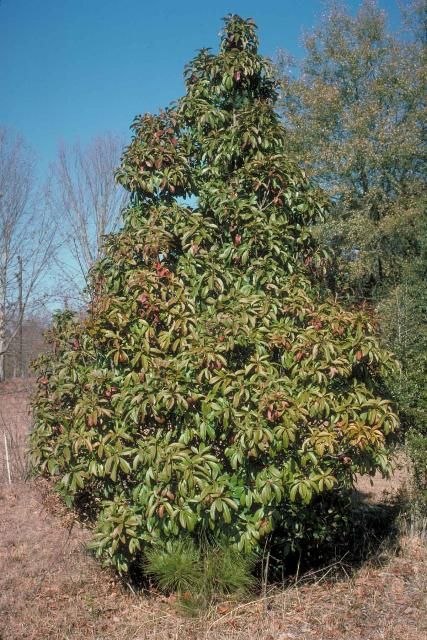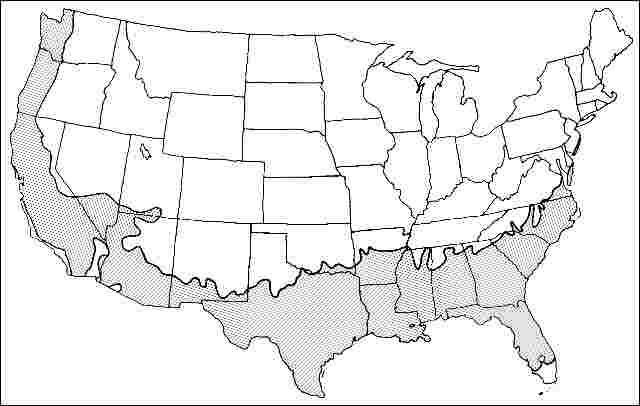Introduction
Growing 12 to 18 feet high by 8 to 12 feet wide, Fraser Photinia forms an upright silhouette of glossy, evergreen leaves. One of the most striking features of Fraser Photinia is the burgundy-red new foliage which contrasts nicely against the dark green mature foliage. Most people do not see the showy white flower clusters borne at the ends of the branches in the summer because they regularly prune the new growth. It is really quite attractive in flower, as the entire crown fills with white for two or three weeks.

Credit: Ed Gilman
General Information
Scientific name: Photinia x fraseri
Pronunciation: foe-TIN-nee-uh x FRAY-zer-eye
Common name(s): Fraser Photinia
Family: Rosaceae
USDA hardiness zones: 7B through 9B (Fig. 2)
Origin: not native to North America
Invasive potential: little invasive potential
Uses: sidewalk cutout (tree pit); hedge; screen; container or planter; trained as a standard; deck or patio; urban tolerant; highway median
Availability: not native to North America

Description
Height: 12 to 18 feet
Spread: 8 to 12 feet
Crown uniformity: symmetrical
Crown shape: upright/erect, oval
Crown density: dense
Growth rate: moderate
Texture: medium
Foliage
Leaf arrangement: alternate (Fig. 3)
Leaf type: simple
Leaf margin: serrate
Leaf shape: obovate, elliptic (oval)
Leaf venation: pinnate
Leaf type and persistence: evergreen, broadleaf evergreen
Leaf blade length: 4 to 8 inches
Leaf color: green, purple/red
Fall color: no color change
Fall characteristic: not showy

Flower
Flower color: white/cream/gray
Flower characteristics: showy
Fruit
Fruit shape: round
Fruit length: less than .5 inch
Fruit covering: fleshy
Fruit color: red
Fruit characteristics: does not attract wildlife; not showy; fruit/leaves not a litter problem
Trunk and Branches
Trunk/bark/branches: branches don't droop; not showy; typically multi-trunked; thorns
Pruning requirement: needed for strong structure
Breakage: resistant
Current year twig color: reddish
Current year twig thickness: thin, medium
Wood specific gravity: unknown
Culture
Light requirement: full sun
Soil tolerances: sand; loam; clay; slightly alkaline; acidic; well-drained
Drought tolerance: high
Aerosol salt tolerance: high
Other
Roots: not a problem
Winter interest: no
Outstanding tree: no
Ozone sensitivity: unknown
Verticillium wilt susceptibility: susceptible
Pest resistance: sensitive to pests/diseases
Use and Management
Ideal for use as a clipped hedge or screen (if you don't mind the bottom of it being on the thin side), Fraser Photinia produces some attractive new red growth all throughout the growing season in USDA hardiness zones 8 and 9. Unfortunately, everyone seems to have discovered the plant and everyone has one (or many) but most people use it as a hedge. Try it as a tree for something different. It is best used as a tall screen in the full sun but is often misused as a foundation plant in front of the house. It grows fine in the shade but leaf spot is sure to follow causing defoliation and disappointment (or jubilation depending upon your persuasion).
Fraser Photinia needs well-drained soil and a full sun location. Leaves often become infected with leaf spot fungi when grown in shade or when the leaves remain too moist. Plants grow at a moderate rate and tolerate pruning very well, although the bottom of the plant often thins when clipped into a hedge. There are better plants for hedges. Micro-nutrient problems occur on alkaline soil, although plants continue to grow. It tolerates heat well and is suited for exposed sites like parking lots and median strips in highways.
Propagation is by cuttings.
Pests
Caterpillars, mites, scales, European fruit-tip moth can be found on photinia but are often of little consequence.
Disease
Fire blight kills the plant rather quickly, leafspot diseases are very serious, and mildew. Root rot can kill plants, particularly those in wet soils. This is not a pest-free plant.